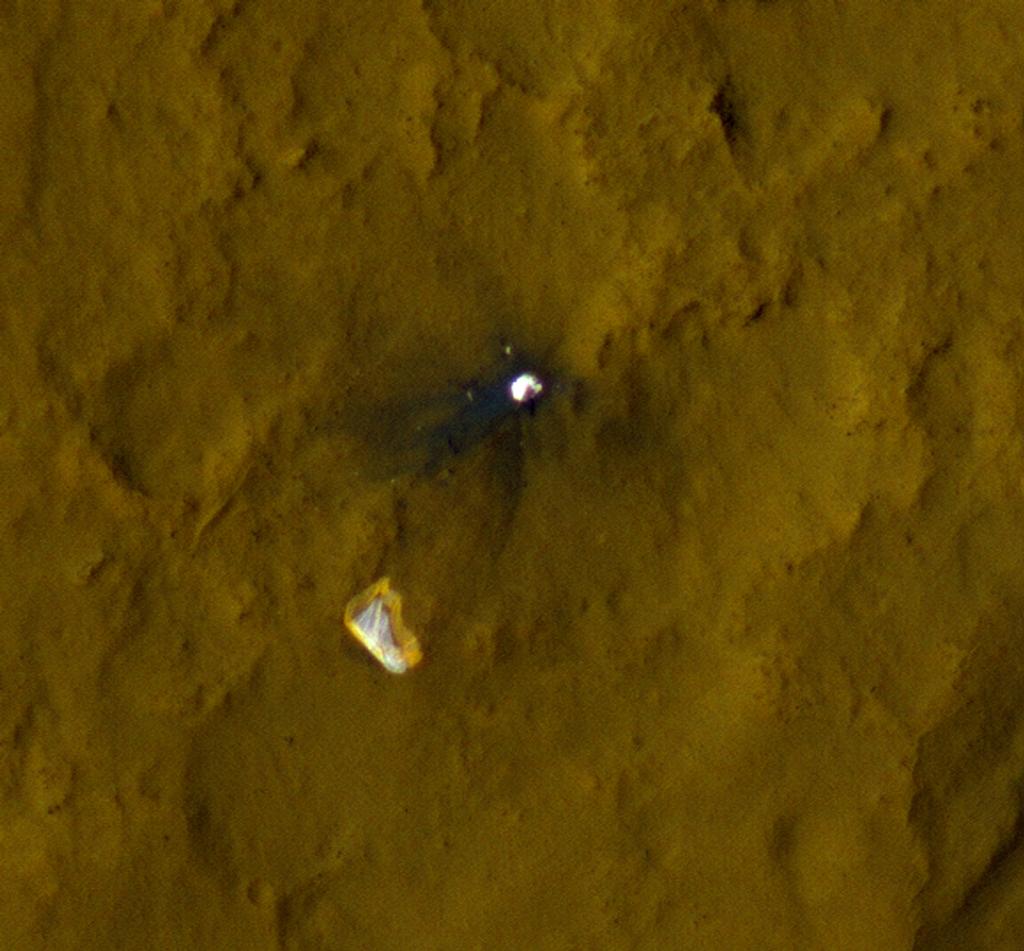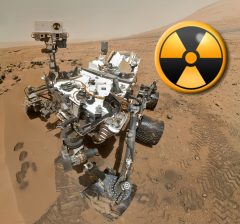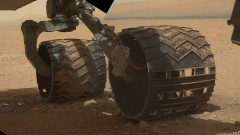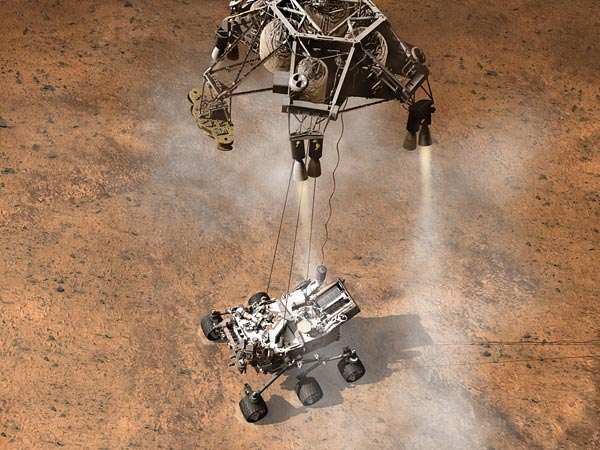
A year ago today, the world watched and waited for the moment of truth, as many months of planning and preparation finally gave way to the “Seven Minutes of Terror.” High above Mars, the incoming Curiosity rover was about to become the United States’ fourth successfully operated rover to land and traverse the surface of the Red Planet. However, unlike its predecessors—Sojourner, Spirit, and Opportunity—the large size and mass of Curiosity meant that an airbag-cushioned touchdown was out of the question. Instead, the 1,980-pound rover depended upon a complex array of parachutes, retrorockets, and a never-before-tried “Sky Crane” to guide it to a pinpoint landing within the 96-mile-wide Gale Crater. In an event which proved as much a miracle as a technological triumph, it succeeded, and Curiosity’s first year has revolutionized our understanding of Mars … so much so that in December 2012 its mission was reportedly extended indefinitely.
Curiosity’s journey to the Red Planet began from Space Launch Complex (SLC)-41 at Cape Canaveral Air Force Station, Fla., in November 2011, atop an Atlas V booster. A little over eight months later, on the night of 5/6 August 2012, it was readied for the perilous, seven-minute-long Entry, Descent, and Landing (EDL) maneuver, which placed it within a “landing ellipse” of just 12 x 4.3 miles, far narrower than anything attempted by any previous mission. Throughout the process, Curiosity operated autonomously, according to pre-loaded software parameters, and was watched “live” by an estimated 3.2 million people on NASA TV, cable networks, or online.

Folded within an “aeroshell” for the bulk of its voyage to Mars, Curiosity separated from its cruise stage about ten minutes ahead of atmospheric entry. Shortly thereafter, thrusters on the aeroshell were fired to cancel out the spacecraft’s slow rotation and the process of entering Mars’ atmosphere began. Protected by a 15-foot-wide heat shield of phenolic impregnated carbon ablator, the cocooned rover survived peak temperatures of 2,090 degrees Celsius and a maximum deceleration of around 15 G. Ejectable ballast mass weights were deployed at several key stages during entry, and reaction control thrusters were fired to provide the aeroshell with sufficient “lift” during this highly dynamic phase.
Within minutes, the incoming spacecraft had slowed to Mach 1.7, and at an altitude of about 6.2 miles above the surface, a 52-foot-diameter parachute was deployed, after which the heat shield separated. Above, in orbit around the Red Planet, NASA’s Mars Reconnaissance Orbiter (MRO) photographed the parachute deployment. Falling further into the atmosphere, the rover and its descent stage separated from the aeroshell at a velocity of 220 mph and an altitude of 1.1 miles. The descent stage consisted of a platform above Curiosity, armed with eight hydrazine engines, which provided 90-700 pounds of variable thrust to slow the descent, after which the Sky Crane lowered the rover with a 25-foot-long tether to a soft, wheels-down landing on the red-hued surface. After detecting and confirming “Weight on Wheels,” a series of pyrotechnic charges cut cables to free Curiosity from the descent stage, which then flew away to a crash landing about 2,100 feet away.

Simply reading that description of Curiosity’s arrival on Mars makes it all the more remarkable that it was pulled off at all, let alone that it was pulled off entirely without incident, although not without a certain amount of nail-biting tension on the part of the mission control team and space enthusiasts around the world. Curiosity achieved Weight on Wheels on the Martian surface at 10:17 p.m. PDT on 5 August (1:17 a.m. EDT and 5:17 a.m. UTC on 6 August 2012) and touched down less than 1.5 miles from its target … after a 350-million-mile journey. Firm confirmation of its successful landing reached the ears of an exuberant flight control team about 14 minutes later.
Its landing site was Gale Crater, an enormous impact basin, 96 miles wide and estimated at somewhere between 3.5 and 3.8 billion years old. Within the crater lies the forbidding 18,000-foot peak of Aeolis Mons (“Mount Sharp”). And here, for the last Earth-year, Curiosity has conducted a truly astounding program of scientific observation and discovery which the whole world has had the opportunity to share and experience.

Since landing, the rover—essentially a six-wheeled mobile laboratory—has provided more than 190 gigabits of data, returned more than 36,700 full images and 35,000 thumbnail images, fired more than 75,000 laser shots to investigate the composition of soils, driven more than a mile, and directly collected and analyzed samples from two separate rocks. Its results so far have exposed geological layers which originated in a wet environment, and examinations of pebble-like deposits have hinted strongly at the presence of ancient, vigorous-flowing stream beds.
“We now know Mars offered favorable conditions for microbial life, billions of years ago,” said Curiosity Project Scientist John Grotzinger of the California Institute of Technology in Pasadena, Calif. “It has been gratifying to succeed, but that has also whetted our appetites to learn more. We hope those enticing layers at Mount Sharp will preserve a broad diversity of other environmental conditions that could have affected habitability.”
To commemorate its year on the surface, NASA has released a video and plans events on NASA Television and the agency’s website on Tuesday, 6 August. There will also be a live public event from NASA Headquarters in Washington, D.C., which is expected to include agency officials and Expedition 36 crew members aboard the International Space Station. “Successes of our Curiosity—that dramatic touchdown, a year ago, and the science findings since then—advance us toward further exploration, including sending humans to an asteroid and Mars,” said NASA Administrator Charlie Bolden. “Wheel tracks now will lead to boot prints later.”
Want to keep up-to-date with all things space? Be sure to “Like” AmericaSpace on Facebook and follow us on Twitter:@AmericaSpace




Curiosity continues its amazing trek on the Martian surface . Imagine – we are “there!” We observe the wonders of the surface and await the potential treasure trove of new discoveries. Put in perspective with the recent photos of our “pale blue dot” from Cassini and Messenger, it is astounding to imagine that intelligent creatures are exploring their neighborhood with sophisticated instruments such as Curiosity. Wow!